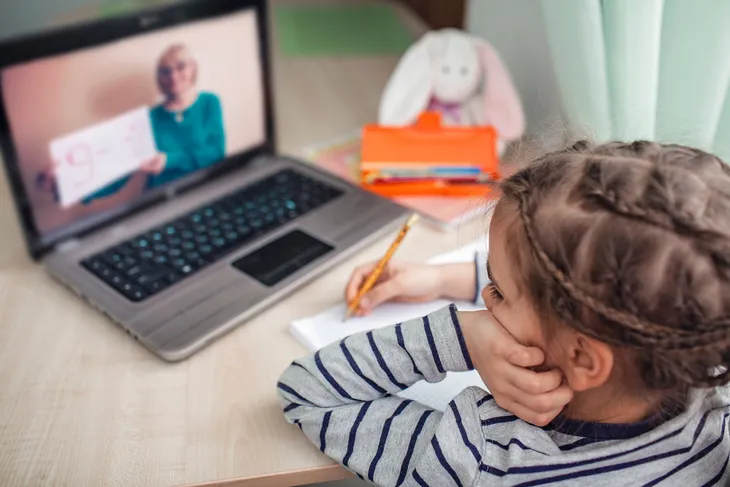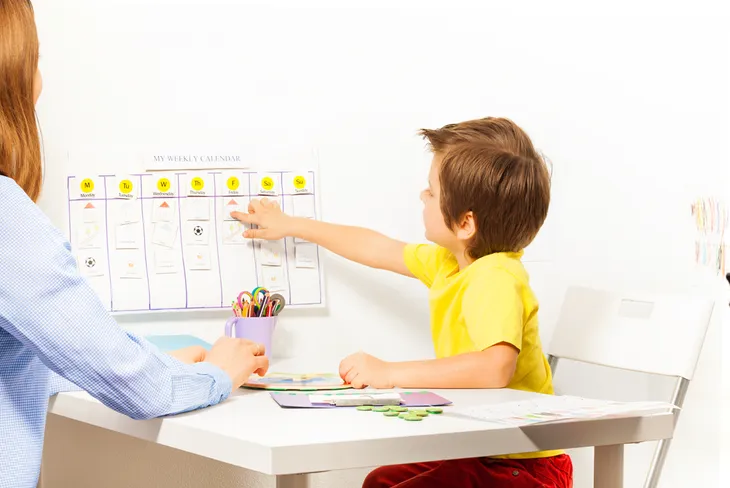If you’re reading this, you’re likely one of the many parents who have turned to homeschooling lately. While children (and adults) are well accustomed to screen time for entertainment, getting a quality education and meeting benchmarks digitally can be a challenge.
While parents, students (and teachers) adjust to delivering educational material online, there are some things you can do to make the process smoother. That means not only helping kids navigate the homework itself, but also structuring their day for the most engagement. Here are some tips to help you while your children learn long-distance…
Create an Ideal Environment
If your child is trying to learn, then they should be given the same considerations that they (hopefully) have at school. “Kids achieve their best work in a quiet, comfortable and dedicated space devoted to learning,” explains Metro Parent.
That means moving their learning space away from where they’d normally watch television or play games, adds the source. Make sure they have a comfortable chair and table so they don’t end up causing them physical strain, and allow them to maintain correct posture.
Limit Online Entertainment
One of the big challenges of doing work digitally is that there is often a bunch of tempting social media apps and games on the same device. That means a high potential for distraction, as they click on notifications from their friends rather than focus on completing school assignments.
There are a couple of ways around this one: you can lock down certain apps on the device, allowing access to only the ones that are needed for learning. This can be done temporarily (you can unlock the apps once they’ve done their schoolwork) or you can limit them permanently. You can also let them use a laptop (or another device) that is dedicated for schoolwork, suggests Metro Parent.
Motivate Each Other
If your child sees other kids doing work online, then they might be more inspired to do their own. Some teachers are encouraging students to send in photos of themselves reading, or even having friendly competitions to see who can read the most books in a given time frame.
Teachers can aid in this process by creating a blog to share what students are up to, and how they’re progressing. If your child’s teacher is not on board with a blog, you can connect with other parents of kids the same age to share what they’ve been up to in terms of learning.
Use The ‘Chunking’ Concept
Expecting kids to memorize large amounts of information in a continuous manner is probably not realistic, at least according to some experts. Instead, you should make “chunking” part of the learning routine. Forbes explains that learning is done effectively when information can be delivered in “small chunks” that can be more easily retained.
It adds that instead of learning one huge piece of information, learning in chunks can be easier on kids because it builds on the previous chunk for repetition and helps to connect the points. It adds that a student’s brain is less likely to become overloaded this way, which can impact quality learning.
Allow Recesses
While school-aged kids won’t be heading out to the playground to play hopscotch for the foreseeable future, it doesn’t mean you shouldn’t provide a recess from digital learning. There’s a reason breaks are built into the curriculum.
That means you can synchronize your timers to allow for breaks at the same times they would normally get them if they were in school. They can use this time to get a snack, stretch, or run around in the yard. After all, taking breaks is important for mental sharpness and motivation, explains Psychology Today.
Turn To Audiobooks
Depending on the age of your child, they may be used to having someone read to them. However, that task doesn’t have to fall squarely on your shoulder as a homeschooler, says Today.com.
The source notes that “audiobooks are more accessible than ever,” and even some actors are doing readings of children’s books (for free) to increase engagement. While libraries may be closed for the time being, e-books can be downloaded from these public resources, it adds.
Show Enthusiasm For Their Learning
Homeschooling is a tough situation for many parents, especially those who are expected to work from home. But while you may be focused on your own work goals, you should take some time out to ask what your child is learning and show some interest to “stimulate self-expression,” says Metro Parent.
Check in with your home student(s) regularly to see what they’re up to, but also to share in their achievements and encourage their creativity. Share their excitement about learning a new topic, and even consider providing rewards for hitting benchmarks, which we’ll get to next.
Create a Reward System
Giving rewards to your kids may be a way to help motivate them while they’re learning at home. But aside from giving them toys or another prize for completing an assignment, which is probably unrealistic as you’d run out of money pretty quickly (and probably set an impossible precedent), there’s another approach – namely reward cards, as outlined by ThisReadingMama.com.
The basic concept is this: at the beginning of the day, your child begins with zero minutes of screen time earned. Each time your child demonstrates “praiseworthy attitudes and work,” they earn 5-minutes of screen time. This is a more positive approach than starting with 30-minutes and taking away time for negative behaviors, it adds. If this doesn’t work for you, then you can always turn to a teacher’s favorite – stickers.
Follow a Schedule
It’s easy to get off track without the usual cues such as school bells. But Metro Parent says that having a plan in place ahead of time can reduce stress on both the student and the parents.
That includes making a learning schedule for the entire week, not just a single day. Help them with listing priorities and setting deadlines for assignments, it adds. Keeping a schedule will also likely make it easier for your child to re-adjust when they’re back to a regular classroom routine.
Include Other Practical Learning
Your teachers may provide a certain amount of course material to get through, including reading and math. But as a homeschooling parent, don’t limit yourself to only teaching the school curriculum – this is also an opportunity to teach some other life skills, suggests Today.com.
For example, you can help break up the routine by including home economics – such as cooking, doing laundry and taking care of the family pet (letting them take the dog for a walk may still be ideal in some areas, as long as all precautions are taken.) It adds that parents can even introduce teenaged children to paying bills online to gain financial literacy.
Be Easy On Yourself And Each Other
This is time for major adjustment for a lot of families, as they navigate fulfilling responsibilities remotely. While you should remind your kids that they aren’t on vacation, and they have schoolwork to do, you should also try to build in some fun and quality time together (because when will you have this much time together again?) notes Metro Parent.
Don’t be afraid to reach out to teachers for help if you’re struggling with online teaching, and use your network of parent friends to see what’s working or not working for them. Try different learning approaches until you find the one that works best for you and your child, and don’t push them to the point of tears and frustration – end each learning session “on a high note,” it adds.













